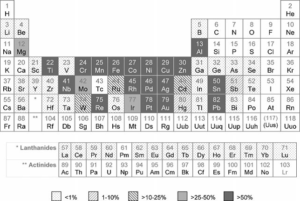AUTHOR: Anas Eldosouky
The importance of metals in our daily life is ubiquitous. Their properties such as fracture toughness, shininess and thermal and electrical conductivity allow them to be used in an unlimited number of applications: including transportation, paints, packaging, appliances and machinery. Moreover, the demand for metals is continuously increasing as they are a keystone for the future technical advances and technology to come. This demand for the daily life and technology applications is also accompanied by an increase in our population. The world population is in a state of continuous growth since the Great Famine and the Black Death in 14th century, when the population was only 370 million1. Our population was estimated to be 7.5 billion on April 24, 20172 and it is expected to reach 11.2 billion in the year of 21003, if we survive climate change by then. But as the reserves of metals on earth are finite, and it will take us some time to develop our aerospace technology to bring metals ores from the outer space, this leaves us with one–and only one–option, which is to recycle metals.
Graedel et al4 (see figure below) calculated the recycling rate for 60 metals in the periodic table. His study concludes that the recycling rate is above 50% for only 18 metals, where the rate is less than 1% for 34 elements.
There are many obstacles standing in the way of metal recycling, the major ones are:
- The presence of some elements in low concentration in the products,
- The lack of recycling schemes for modern goods,
- The lack of the awareness of recycling importance in developing countries.
But as previously stated, metals recycling should no longer be optional; we need worldwide awareness and collaboration to increase the rate of metal recycling. For example, governments, especially in the advanced countries, could contribute in a number of ways:
- to give a subsidy on the products made out of recycled metals or to decrease the taxes for those goods,
- to put more money in the recycling infrastructures to be up-to-date with the complexity of the modern products,
- to ask companies and providers to present expected recycling methods and quantities before launching a product in the market,
- to help developing countries to build their own recycling plants.
In the end, so far, Earth is the only planet we have, when paving the way for the modern technology we also must bear in mind that we have limited resources.
The periodic table of global average end-of-life functional recycling rates (EOL-RR) for 60 metals4
References
- Jean-Noël Biraben (1980), “An Essay Concerning Mankind’s Evolution”.Population, Selected Papers. Vol. 4. pp. 1–13. Original paper in French: (b) Jean-Noël Biraben (1979).”Essai sur l’évolution du nombre des hommes”. Population. Vol. 34 (no. 1). pp. 13–25.
- “World Population Clock: 7.5 Billion People (2017) – Worldometers”.worldometers.info. Retrieved 2017-03-18.
- “World Population Prospects – Population Division – United Nations”.un.org. Retrieved 2016-09-15.
- E. Graedel, Julian Allwood, Jean-Pierre Birat, Matthias Buchert, Christian Hagel¨uken, Barbara K. Reck, Scott F. Sibley, and Guido Sonnemann, Journal of Industrial Ecology, Volume 15, Number 3 (355-366), 2011.

 European Training Network for the Design and Recycling of Rare-Earth Permanent Magnet Motors and Generators in Hybrid and Full Electric Vehicles (DEMETER)
European Training Network for the Design and Recycling of Rare-Earth Permanent Magnet Motors and Generators in Hybrid and Full Electric Vehicles (DEMETER)


